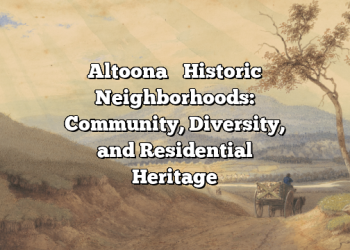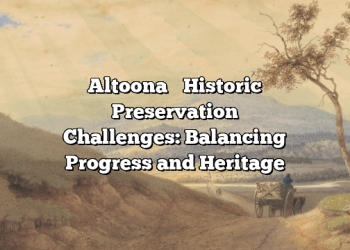The Civil War period was an exciting and transformative era for our nation, and Hollidaysburg and Altoona, two neighboring towns in Pennsylvania, were no exceptions. Like many regions during this time, these towns braved the storm of the war and emerged stronger and more dynamic. Let’s take a journey back in time and explore how the Civil War era shaped Hollidaysburg and Altoona, from their economy, culture, transportation, to their people.
A Glimpse into the Past
Located in Blair County in Pennsylvania, both Hollidaysburg and Altoona carry a rich history deeply interwoven with the Civil War era. Hollidaysburg, being the county seat, held a strategic location crucial for transportation and trade. Altoona, on the other hand, was known for its thriving railroad industry, enticing a wide range of people from different backgrounds.
The Dawn of the Civil War
As the Civil War started to unfold, it brought about significant changes in these towns. Tensions ran high, and everyone braced themselves for the uncertainty that the war would bring. But even amidst the chaos, the townsfolk of Hollidaysburg and Altoona showed resilience by adapting to the changing times, a testament to their enduring spirit.
The War and its Effects
While the Civil War had devastating effects across the nation, it also brought about new opportunities and challenges in Hollidaysburg and Altoona. These two towns played pivotal roles in the war, with their industries and trade routes aiding the North’s war efforts. As we navigate through this era, we will see how the war left an indelible mark on these towns, shaping their destiny and leaving behind a legacy that continues to this day.
The Power of History
Understanding how the Civil War era influenced Hollidaysburg and Altoona is vital in appreciating the towns’ present. The grit and perseverance shown by the townsfolk during this turbulent period are reflected in the character of the towns today. The echoes of the past still resonate, reminding us of the enduring spirit of these towns.
So, come along as we delve into the rich history of Hollidaysburg and Altoona during the Civil War era. Together, we will discover how this period shaped these towns’ economy, society, and culture, and the significant role of the Pennsylvania Railroad. We will also highlight notable figures and events that left a lasting impact, eventually leading to how these towns remember and honor their Civil War history today.
As we embark on this historical journey, remember that through understanding our past, we gain a deeper appreciation of our present and a clear direction for our future. So, are you ready for an adventure back in time? Let’s dive in!
Historical Background: Hollidaysburg & Altoona during the Civil War
Step back with me, if you will, into the mid-19th century, where we find ourselves in the midst of the Civil War era. Hollidaysburg and Altoona, nestled in the scenic heart of Pennsylvania, are two towns with rich histories that were significantly shaped by this tumultuous period. Let’s delve into the fascinating backstory of these charming towns during the Civil War.
A Tale of Two Towns
If we could take a stroll through Hollidaysburg in the 1860s, we’d find a lively canal town bustling with activity. On the other hand, Altoona, with its sprawling railroad yards, was a rapidly expanding industrial powerhouse. These two towns, though different in character, both played crucial roles during the Civil War.
In Hollidaysburg, the Allegheny Portage Railroad and the Main Line Canal were vital in transporting goods and people across the state. Hollidaysburg provided an important link in the Pennsylvania transportation network, and during the Civil War, it helped move troops and supplies for the Union Army.
- Hollidaysburg: A bustling canal town.
- Altoona: An industrial powerhouse with sprawling railroad yards.
Altoona’s Railroad Legacy
In Altoona, the Pennsylvania Railroad’s massive complex was a hive of activity. The railroad played a pivotal role in the war effort, and Altoona quickly became a strategic hub. The town’s workshops and factories churned out locomotives, cars, and other essential equipment for the Union Army. During the Civil War, Altoona was known as the ‘Railroad City’.
War and Community
The Civil War had a profound impact on the people of Hollidaysburg and Altoona. Many local men enlisted in the Union Army, leaving their homes and families to fight in distant battles. The war also brought a wave of new jobs, as the demand for transportation and manufacturing skyrocketed. For better or worse, the Civil War was a defining time for these two towns, shaping their histories in ways still visible today.
So there you have it – a brief glimpse into the captivating past of Hollidaysburg and Altoona during the Civil War. A time of change, challenge, and perseverance that forever etched these two towns into the annals of American history.
Economic Impact: How the Civil War Influenced Trade and Industry in Hollidaysburg & Altoona
If there’s a story to be told about resilience and evolution, it’s the story of Hollidaysburg and Altoona during the Civil War. This era brought about significant changes in both towns, especially in the realm of trade and industry. So, let’s take a stroll through history and see how this war shaped the economic landscape of these two Pennsylvania towns.
War-time Economy in Hollidaysburg
Before the Civil War, Hollidaysburg was already a busy trade center, thanks to its strategic location along the Pennsylvania Canal. However, with the advent of the Civil War, the town found itself at the heart of a bustling wartime economy. The war brought an unexpected boom to local industries, especially those involved in the production of arms, ammunition, and other critical supplies for Union soldiers.
The Rise of Altoona’s Industrial Might
Meanwhile, Altoona’s star was rising. The town was a relatively new settlement, having been founded in 1849 as a railroad town. The Civil War, however, catapulted Altoona onto the national stage. As the hub of the Pennsylvania Railroad, Altoona became the primary provider of locomotives and railroad cars for the Union Army. The town’s industries worked around the clock to meet the war’s demands, leading to unprecedented growth and prosperity.
The Effect on Local Businesses
It wasn’t just the heavy industries that thrived during the Civil War. Local businesses in both Hollidaysburg and Altoona also experienced a boom. Entrepreneurs capitalized on the increased population and demand for goods and services, opening everything from bakeries to clothing stores. The war, while devastating in many ways, brought about an economic renaissance in these towns.
Post-War Economic Transformation
When the smoke of the Civil War cleared, both Hollidaysburg and Altoona had to adapt to a peacetime economy. And adapt they did! The skills and infrastructure developed during the war helped the towns transition into manufacturing centers. Hollidaysburg continued to thrive as a trade hub, while Altoona cemented its status as a railroad town. The Civil War, in many ways, set the stage for the economic prosperity that Hollidaysburg and Altoona enjoyed in the years to come.
In conclusion, the Civil War had a profound impact on the economies of Hollidaysburg and Altoona. It spurred industrial growth, boosted local businesses, and laid the groundwork for the towns’ future economic success. It’s a testament to the adaptability and resilience of these communities, a story that continues to inspire us even today.
Social Changes: Examining the Shifts in Society and Culture in Hollidaysburg & Altoona post-Civil War
Are you curious about the societal and cultural shifts that occurred in Hollidaysburg and Altoona after the Civil War? Well, you’re in the right place. Let’s dive into how the people of these towns re-shaped their society and culture in the wake of this monumental historical event.
Shift in Labor Force
One of the most significant social changes that came about in Hollidaysburg and Altoona was the shift in the labor force. Prior to the Civil War, these towns had a labor force that was largely agricultural. However, the war led to a great need for industrial goods, causing a shift towards industrialization. This resulted in a transformation of the labor force, with more people moving into industrial jobs, particularly in the booming railway industry.
Improved Education System
Another notable shift in the post-war era was in the realm of education. In the wake of the Civil War, there was an increased emphasis on education in the towns of Hollidaysburg and Altoona. Recognizing the need for a more educated workforce, particularly in the burgeoning railway industry, these towns invested heavily in education. This led to the establishment of several new schools, and an overall improvement in the quality of education.
Changes in Social Structure
- The rise of the middle class: As the towns of Hollidaysburg and Altoona underwent industrialization, there was a rise in the middle class. This new class of professionals, including railway workers, teachers, and merchants, wielded considerable influence over the social and cultural life of these towns.
- Increased diversity: The post-war period also saw an increase in the diversity of these towns. The need for labor in the growing railway industry attracted immigrants from various countries, enriching the culture of Hollidaysburg and Altoona.
The Emergence of New Social Norms
Last but not least, the post-Civil War era in Hollidaysburg and Altoona ushered in new social norms. With the emancipation of slaves, the fight for gender equality gaining momentum, and the influx of immigrants, the social fabric of these towns was forever changed. These changes paved the way for a more inclusive society, which we see reflected in these towns today.
That’s a wrap on the major social changes that Hollidaysburg and Altoona underwent in the post-Civil War era. Fascinating, don’t you think? It’s truly amazing to see how these towns evolved and adapted to the changing times. Stay tuned to explore more about the Civil War’s impacts on Hollidaysburg and Altoona!
The Role of the Pennsylvania Railroad: Transportation and The Civil War in Hollidaysburg & Altoona
When it comes to understanding the monumental impact of the Civil War on Hollidaysburg and Altoona, we simply can’t ignore the significant role played by the Pennsylvania Railroad. It changed the game, not just for these towns, but also for the entire North, accelerating transportation and communication during a time of intense conflict.
The Lifeline of the Union
The Pennsylvania Railroad was often referred to as the “lifeline of the Union”. Indeed, this title was more than well-deserved. Established in 1846, it soon became the largest railroad by traffic and revenue in the U.S. for the first half of the 20th century. But its glory days truly began with the onset of the Civil War.
- It was instrumental in moving troops and supplies swiftly across the state, strengthening the Union’s fighting capability.
- As manufacturing industries boomed in Hollidaysburg and Altoona, the Pennsylvania Railroad also facilitated the transportation of vital goods, contributing to the war effort and boosting the local economy.
The Horseshoe Curve
One of the major feats of engineering associated with the Pennsylvania Railroad is the Horseshoe Curve, located near Altoona. This marvel of transportation engineering was a vital link in the Pennsylvania Railroad, allowing trains to traverse the steep Allegheny Mountains. During the Civil War, the Horseshoe Curve played a crucial role in delivering resources and soldiers to where they were most needed. It was so integral to the Union’s efforts that it even became a target for Confederate forces, highlighting its strategic importance.
Shaping Altoona and Hollidaysburg
Though the Pennsylvania Railroad was a significant asset for the Union during the Civil War, it also profoundly influenced the growth and development of Hollidaysburg & Altoona. The railroad brought jobs, people, and wealth to these towns. Altoona, in particular, saw astonishing growth, transforming from a small town into a bustling city. The railroad industry also stimulated the growth of related industries, enhancing the overall economic prosperity of these regions.
In the Aftermath of War
Even after the war ended, the Pennsylvania Railroad continued to shape the destiny of Hollidaysburg and Altoona. As the towns transitioned from war to peace, the railroad remained a vital part of their economies. It helped to rebuild communities, foster new industries, and create a lasting legacy that is still felt today.
In conclusion, the Pennsylvania Railroad was not just a means of transportation during the Civil War. It was a lifeline, a catalyst for growth, and a symbol of resilience and progress for Hollidaysburg and Altoona. So when you step off the train at Hollidaysburg or Altoona station, remember, you’re treading on historical ground!
Notable Figures and Events: Key Players and Milestones in Hollidaysburg & Altoona during the Civil War Era
Let’s journey back in time and learn about some of the key figures and events that helped shape the history of Hollidaysburg and Altoona during the tumultuous Civil War era. These individuals and incidents played a pivotal role in the communities’ survival and growth during that challenging period.
Joseph Skelly: A brave Union soldier
One cannot talk about Hollidaysburg’s Civil War history without mentioning Joseph Skelly. Recognized for his bravery, Skelly was a Union soldier from Hollidaysburg who served in the 46th Pennsylvania Infantry. He was remembered for having fought in major battles, including the Battle of Antietam. His courage under fire is an emblem of the indomitable spirit of the people of Hollidaysburg during the Civil War.
Hollidaysburg Canal Basin Park: The lifeline during the war
The Hollidaysburg Canal Basin Park, now a historic site as well as a recreational area, played a crucial role during the Civil War. It served as a significant point of transfer for goods and troops, contributing to the war effort and helping keep Altoona and Hollidaysburg afloat during those tumultuous times.
The Role of Altoona
Altoona, the railroad city, played a significant part in the Civil War. The Pennsylvania Railroad had its principal shop in Altoona, and the city’s strategic location made it a key transportation hub. The Horseshoe Curve, a three-track railroad curve, was a vital link connecting the eastern and western states, allowing for faster movement and supply of troops and goods. During the war, it was heavily guarded to prevent Confederate attacks.
Robert E. Lee’s Invasion of Pennsylvania
One significant event in Altoona’s Civil War history was Confederate General Robert E. Lee’s Invasion of Pennsylvania. Fear gripped the city as news of Lee’s advancing troops spread. However, the people of Altoona bravely defended their city, ensuring its survival.
John White Geary: An influential figure
Another notable figure in Altoona’s history is John White Geary, a Union general who later served as the Governor of Pennsylvania. Geary also played a crucial role during the Civil War, leading troops in major battles. His contributions towards preserving the Union left an indelible mark on Altoona’s history.
To conclude, the Civil War era saw many prominent figures and significant events in Hollidaysburg and Altoona. Their courage and resilience during these challenging times provide a rich tapestry of history for the current and future generations to learn from and take pride in.
The Legacy of the Civil War: How Hollidaysburg & Altoona Remember and Honor their Civil War History
The Civil War left an indelible mark on the United States, forever shaping its history and the stories of its cities. Hollidaysburg and Altoona, two small but significant cities in Pennsylvania, are no different. They continue to honor their Civil War history in ways that are both touching and evocative, ensuring their rich history is never forgotten.
Memorials and Monuments
One of the most visible ways Hollidaysburg and Altoona honor their Civil War history is through memorials and monuments. These historical markers are a testament to the cities’ role in the war and the sacrifices made by their citizens.
In Hollidaysburg, the Blair County Civil War Soldier Monument is a prominent feature of the city center. Erected in 1866, it serves as a somber reminder of the local soldiers who bravely fought during the war.
Altoona, on the other hand, is home to the Altoona Area Veterans Memorial, an impressive monument that honors the veterans of all wars, including the Civil War. A yearly commemoration ceremony is held here, a community tradition that fosters reflection and gratitude.
Events and Celebrations
Both cities also honor their history through annual events and celebrations. For instance, the Civil War Days held in Hollidaysburg is a popular event that draws crowds from all over the region. It includes reenactments, living history exhibits, and educational seminars, making history come alive in a fun and engaging way.
Historical Landmarks
Historical landmarks such as the Horseshoe Curve in Altoona and the Hollidaysburg Canal Basin Park are also maintained to educate residents and visitors about the cities’ Civil War history. The Horseshoe Curve was a significant part of the Pennsylvania Railroad during the war, while the Canal Basin Park showcases the importance of the canal system to Hollidaysburg during the era.
The Civil War Roundtable
Lastly, the Blair County Civil War Roundtable provides a platform for Civil War enthusiasts to learn and share knowledge about the era. Monthly meetings often feature guest speakers and presentations, making it a vibrant part of the city’s commemoration efforts.
In conclusion, Hollidaysburg and Altoona show great reverence for their Civil War history, ensuring that the memories of those who fought and the lessons learned from this tumultuous time are never forgotten. From monuments and memorials to historical landmarks and community gatherings, these cities provide a blueprint on how to honor and remember history in a dignified and respectful manner.








